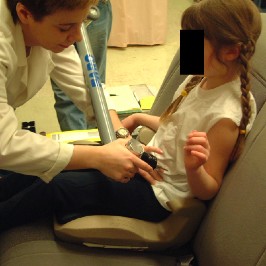>>> Research: Child Anthropometry
Child Anthropometry and Posture

The best available anthropometry data for U.S. children were gathered by an UMTRI team during the 1970s. These data have limited utility for vehicle applications because the standard anthropometric postures are dissimilar in important ways from the postures children use in vehicles. We conducted a study of 68 children from 40 to 100 lb sitting in a variety of vehicle- and booster-seat conditions to quantify the children's postures. We gathered data on torso dimensions, particularly depths and breathds, to provide more relevant data for crash dummy design. In general, children's vehicle-seated postures are more slumped than the fully erect postures measured in the standard anthro surveys.
We have extensive experience using the data from the 1977 UMTRI child anthropometry study conducted for the Consumer Product Safety Commission. The data are available on the downloads page, but must be used with care because they are not representative of contemporary children. Most noteably, U.S. children today are on average heavier at any particular age or stature, and hence weight-related measures, such as circumferences, are generally larger than reported in the 1970s data.
2015 UPDATE: My colleague Matt Parkinson and his student Brian Pagano collaborated on an innovative reweighting of the 1977 Snyder data to identify how child body dimensions have changed in the intervening decades. This analysis makes clear that a major new study of U.S. child anthropometry is needed.
Child Body Shape Modeling
We have conducted detailed investigations of child body shapes for application to a wide range of design problems, including the specifications for crash test dummies. In a recent study, we used a handheld laser scanner to record the shapes of children's spines and shoulders in a wide range of postures. We have used these data to develop target specifications for the corresponding parts of crash dummies and computational models representing children from ages 6 to 12. The shoulder data were analyzed using statistical methods similar to those applied to modeling skeletal geometry and whole-body shape data.
Our latest three-dimensional models of child body size and shape are available at HumanShape.org.
For more on anthropometric research, see:
©2024 Matthew P. Reed and The University of Michigan